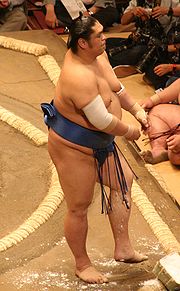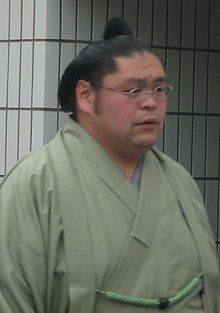
Tochinonada Taiichi
Encyclopedia
Tochinonada Taiichi is a sumo
wrestler from Ishikawa Prefecture
, Japan
. A former amateur sumo champion, he turned professional in 1996 and has been ranked in the top makuuchi
division since 1997. He has earned twelve kinboshi
or gold stars for defeating yokozuna, the second highest ever. His highest rank has been sekiwake.
, he was a rival of fellow top division wrestler Dejima
in elementary school. He was an amateur sumo champion at Takushoku University
, winning the College Yokozuna title. He joined Kasugano stable
through a connection to Chigonoura Oyakata (the former sekiwake Masudayama), who was a fellow Takushoku University alumni and a coach at the stable, and made his professional debut in January 1996. Because of his amateur achievements he had makushita tsukedashi status, and so his debut tournament was in the third highest makushita division. He made the jūryō division in November 1996, switching from his family name of Gotō and adopting the shikona
of Tochinonada. He was promoted to the top makuuchi
division three tournaments later in May 1997.
Tochinonada had a strong start to his makuuchi career, earning special prizes
for Fighting Spirit in consecutive tournaments in July and September 1997. He made his titled sanyaku debut that November at the rank of komusubi. However he could manage only six wins there and did not return to the sanyaku ranks until January 2001, when he made komusubi once again. He reached his highest rank of sekiwake in March 2001 and held it for two tournaments. He was runner-up in the January 2003 tournament, when he lost his first four matches but then rallied to win eleven in a row to finish three wins behind Asashoryu. He was also runner-up to Kaio
in September 2004, where he also scored 11-4.
In May 1999 he injured ligaments in his left elbow in a match against Kaio and had to sit out the following tournament in July. He did not miss any more bouts until six years later in July 2005 when he injured his right thigh on the second day and missed the rest of the tournament.
 During his long stay in the top division Tochinonada has earned twelve kinboshi
During his long stay in the top division Tochinonada has earned twelve kinboshi
or gold stars for defeating yokozuna while ranked as a maegashira, which places him equal second on the all time list, level with Takamiyama
and behind only Akinoshima. His first kinboshi came in January 1998 when he defeated Akebono
, and he earned his next three in three successive tournaments from May to September 1998. In November 2003 he defeated two yokozuna on two successive days, and was awarded the Outstanding Performance prize as well. He has defeated all the yokozuna he has met at least once, with the exception of Hakuhō (his victory over Takanohana was at sekiwake rank, meaning he was not eligible for a gold star on that occasion). In July 2008, he defeated Asashoryu, gaining his 12th kinboshi. He touched the ground before Asashoryu, but Asashoryu had already gone out of the ring, and was therefore shini-tai
.
Tochinonada won his 500th career match in July 2007, producing a strong 10-5 score. He was promoted up the rankings to maegashira 2 in September 2007 and fought his first yokozuna bout since May 2005 when he met Hakuhō
on the 4th day. He had a win over ōzeki Kotoōshū
but finished the tournament with a 4-11 record. In March 2008 he recovered from losing his first six bouts to win eight in a row and achieve kachi-koshi.
 Tochinonada was an ever-present in the top division from May 1997 to November 2005, a run of 52 consecutive tournaments. After dropping to the second division he immediately won the jūryō yusho
Tochinonada was an ever-present in the top division from May 1997 to November 2005, a run of 52 consecutive tournaments. After dropping to the second division he immediately won the jūryō yusho
in January 2006 and was promoted straight back. After another run of 22 makuuchi tournaments he was demoted to the jūryō division again after the September 2009 tournament, and he has moved back and forth between the top two divisions since then. In the January 2011 tournament, Tochinonada managed a 7-0 start after 7 days, his best start to date, although he finished on 9-6. Following the retirement of Kaio
in the July 2011 tournament he became the active wrestler with the most wins in the top division (556), but could not avoid demotion to juryo. In September he recorded his first ever make-koshi in the juryo division, scoring only 4-11.
. His favoured grip is hidari-yotsu (left hand inside, right hand outside), for which he is well known. His most common winning kimarite
is yori-kiri (force out) but he also regularly uses his preferred inside grip to win by shitatenage (underarm throw). He is also fond of oshi dashi (push out) and tsuki otoshi (thrust over).
withdrew, followed the next day by his brother Takanohana. However he did not receive a kinboshi for these victories.
Sumo
is a competitive full-contact sport where a wrestler attempts to force another wrestler out of a circular ring or to touch the ground with anything other than the soles of the feet. The sport originated in Japan, the only country where it is practiced professionally...
wrestler from Ishikawa Prefecture
Ishikawa Prefecture
is a prefecture of Japan located in the Chūbu region on Honshū island. The capital is Kanazawa.- History :Ishikawa was formed from the merger of Kaga Province and the smaller Noto Province.- Geography :Ishikawa is on the Sea of Japan coast...
, Japan
Japan
Japan is an island nation in East Asia. Located in the Pacific Ocean, it lies to the east of the Sea of Japan, China, North Korea, South Korea and Russia, stretching from the Sea of Okhotsk in the north to the East China Sea and Taiwan in the south...
. A former amateur sumo champion, he turned professional in 1996 and has been ranked in the top makuuchi
Makuuchi
or is the top division of professional sumo. Its size is fixed at 42 wrestlers , ordered into five ranks according to their ability as defined by their performance in previous tournaments....
division since 1997. He has earned twelve kinboshi
Kinboshi
Kinboshi is a notation used in professional sumo wrestling to record a lower-ranked wrestler's victory over a yokozuna....
or gold stars for defeating yokozuna, the second highest ever. His highest rank has been sekiwake.
Career
Born in NanaoNanao, Ishikawa
is a city located in Ishikawa prefecture, Japan.As of March 1, 2010, the city has an estimated population of 58,204 and a population density of 183 persons per km². Nanao is the fifth largest city by population in Ishikawa, behind Kanazawa, Hakusan, Komatsu, and Kaga.Nanao is situated in the...
, he was a rival of fellow top division wrestler Dejima
Dejima Takeharu
Dejima Takeharu is a former sumo wrestler from Kanazawa, Ishikawa, Japan. A former amateur champion, he made his professional debut in 1996, reaching the top makuuchi division the following year...
in elementary school. He was an amateur sumo champion at Takushoku University
Takushoku University
Takushoku University is a private university in Japan. It was founded in 1900 by Prince Taro Katsura . The university is located in Tokyo and has two campuses: the main campus in the Bunkyō district, and a satellite campus in the Hachiōji district...
, winning the College Yokozuna title. He joined Kasugano stable
Kasugano stable
is a stable of sumo wrestlers, part of the Dewanoumi group of stables. As of November 2007 it had 24 wrestlers. It is currently one of the most successful stables, with five sekitori wrestlers, including the Georgian Tochinoshin and the Korean born Tochinowaka, who uses the current head coach's...
through a connection to Chigonoura Oyakata (the former sekiwake Masudayama), who was a fellow Takushoku University alumni and a coach at the stable, and made his professional debut in January 1996. Because of his amateur achievements he had makushita tsukedashi status, and so his debut tournament was in the third highest makushita division. He made the jūryō division in November 1996, switching from his family name of Gotō and adopting the shikona
Shikona
A shikona is a sumo wrestler's ring name.As with standard Japanese names, a shikona consists of a 'surname' and a 'given' name, and the full name is written surname first. However, the given name is rarely used outside formal or ceremonial occasions. Thus, the former yokozuna Asashōryū Akinori is...
of Tochinonada. He was promoted to the top makuuchi
Makuuchi
or is the top division of professional sumo. Its size is fixed at 42 wrestlers , ordered into five ranks according to their ability as defined by their performance in previous tournaments....
division three tournaments later in May 1997.
Tochinonada had a strong start to his makuuchi career, earning special prizes
Sansho (Sumo)
Sanshō are the three special prizes awarded to top division sumo wrestlers for exceptional performance during a sumo honbasho or tournament. The prizes were first awarded in November 1947.-Criteria:...
for Fighting Spirit in consecutive tournaments in July and September 1997. He made his titled sanyaku debut that November at the rank of komusubi. However he could manage only six wins there and did not return to the sanyaku ranks until January 2001, when he made komusubi once again. He reached his highest rank of sekiwake in March 2001 and held it for two tournaments. He was runner-up in the January 2003 tournament, when he lost his first four matches but then rallied to win eleven in a row to finish three wins behind Asashoryu. He was also runner-up to Kaio
Kaio Hiroyuki
Kaiō Hiroyuki is a former professional sumo wrestler from Nōgata, Fukuoka, Japan.He made his debut in 1988, reaching the top makuuchi division in 1993. He held the second highest rank of ōzeki or champion for eleven years from 2000 to 2011, and is the longest-serving ozeki of all time in terms of...
in September 2004, where he also scored 11-4.
In May 1999 he injured ligaments in his left elbow in a match against Kaio and had to sit out the following tournament in July. He did not miss any more bouts until six years later in July 2005 when he injured his right thigh on the second day and missed the rest of the tournament.

Kinboshi
Kinboshi is a notation used in professional sumo wrestling to record a lower-ranked wrestler's victory over a yokozuna....
or gold stars for defeating yokozuna while ranked as a maegashira, which places him equal second on the all time list, level with Takamiyama
Takamiyama Daigoro
Takamiyama Daigorō 高見山大五郎 is a former sumo wrestler, the first foreign born rikishi to win the top division championship . His highest rank was sekiwake...
and behind only Akinoshima. His first kinboshi came in January 1998 when he defeated Akebono
Akebono Taro
is a retired American born-Japanese sumo wrestler from Waimānalo, Hawaii. Joining the professional sport in Japan in 1988, he was trained by pioneering Hawaiian sumo wrestler Takamiyama and rose swiftly up the rankings, reaching the top division in 1990...
, and he earned his next three in three successive tournaments from May to September 1998. In November 2003 he defeated two yokozuna on two successive days, and was awarded the Outstanding Performance prize as well. He has defeated all the yokozuna he has met at least once, with the exception of Hakuhō (his victory over Takanohana was at sekiwake rank, meaning he was not eligible for a gold star on that occasion). In July 2008, he defeated Asashoryu, gaining his 12th kinboshi. He touched the ground before Asashoryu, but Asashoryu had already gone out of the ring, and was therefore shini-tai
Shini-tai
is a term used in sumō wrestling. In general, the first sumo wrestler to touch any body part outside the ring, or have any part of his body other than the soles of his feet touch the ground loses...
.
Tochinonada won his 500th career match in July 2007, producing a strong 10-5 score. He was promoted up the rankings to maegashira 2 in September 2007 and fought his first yokozuna bout since May 2005 when he met Hakuhō
Hakuho Sho
is a professional sumo wrestler from Ulan Bator, Mongolia. Making his debut in March 2001, he reached the top makuuchi division in May 2004. On May 30, 2007 at the age of 22 he became the second native of Mongolia, and the fourth non-Japanese overall, to be promoted to the highest rank in sumo,...
on the 4th day. He had a win over ōzeki Kotoōshū
Kotooshu Katsunori
Kotoōshū Katsunori is a professional sumo wrestler or rikishi. He made his debut in 2002, reaching the top division just two years later...
but finished the tournament with a 4-11 record. In March 2008 he recovered from losing his first six bouts to win eight in a row and achieve kachi-koshi.

Yusho
A Yūshō is a tournament championship in sumo. It is awarded in each of the six annual honbasho or official tournaments, to the wrestler who wins the most number of bouts. Yūshō are awarded in all six professional sumo divisions...
in January 2006 and was promoted straight back. After another run of 22 makuuchi tournaments he was demoted to the jūryō division again after the September 2009 tournament, and he has moved back and forth between the top two divisions since then. In the January 2011 tournament, Tochinonada managed a 7-0 start after 7 days, his best start to date, although he finished on 9-6. Following the retirement of Kaio
Kaio Hiroyuki
Kaiō Hiroyuki is a former professional sumo wrestler from Nōgata, Fukuoka, Japan.He made his debut in 1988, reaching the top makuuchi division in 1993. He held the second highest rank of ōzeki or champion for eleven years from 2000 to 2011, and is the longest-serving ozeki of all time in terms of...
in the July 2011 tournament he became the active wrestler with the most wins in the top division (556), but could not avoid demotion to juryo. In September he recorded his first ever make-koshi in the juryo division, scoring only 4-11.
Fighting style
Tochinonada is a yotsu-sumo wrestler, preferring grappling techniques that involve grabbing the opponent's mawashiMawashi
In sumo, a mawashi is the belt that the rikishi wears during training or in competition. Upper ranked professional wrestlers wear a keshō-mawashi as part of the ring entry ceremony or dohyo-iri.-Mawashi:...
. His favoured grip is hidari-yotsu (left hand inside, right hand outside), for which he is well known. His most common winning kimarite
Kimarite
Kimarite are winning techniques in a sumo bout. For each bout in a Grand Sumo tournament , a sumo referee, or gyoji, will decide and announce the type of kimarite used by the winner...
is yori-kiri (force out) but he also regularly uses his preferred inside grip to win by shitatenage (underarm throw). He is also fond of oshi dashi (push out) and tsuki otoshi (thrust over).
Trivia
In March 1999 he became the first wrestler ever to win by default two days in a row. On Day 10 yokozuna WakanohanaWakanohana Masaru
is a former sumo wrestler from Tokyo, Japan. As an active wrestler he was known as Wakanohana III Masaru , and his rise through the ranks alongside his younger brother Takanohana Koji saw a boom in sumo's popularity in the early 1990s...
withdrew, followed the next day by his brother Takanohana. However he did not receive a kinboshi for these victories.
Tournament record
See also
- Glossary of sumo termsGlossary of sumo termsThe following words are terms used in sumo wrestling in Japan. azukari : Hold. A kind of draw. After a mono-ii, the gyōji or the shimpan "holds" the result if it was too close to call...
- List of sumo tournament second division winners
- List of sumo record holders
- List of active sumo wrestlers
External links
- Japanese Sumo Association Biography (English)
- Tochinonada's basho results

